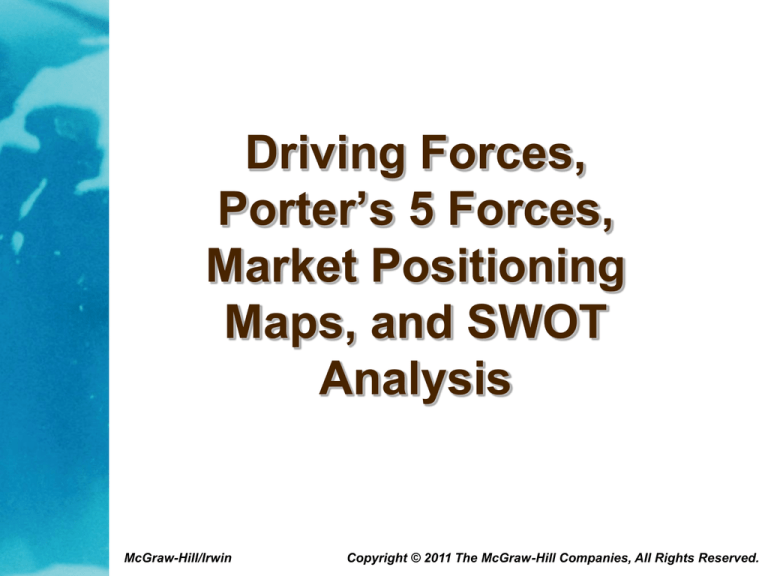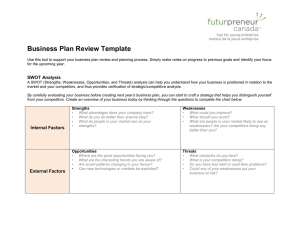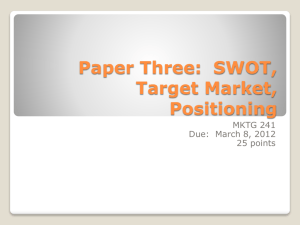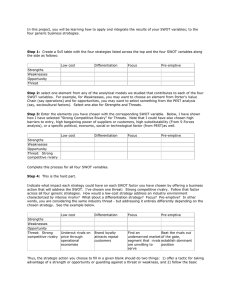
Driving Forces,
Porter’s 5 Forces,
Market Positioning
Maps, and SWOT
Analysis
McGraw-Hill/Irwin
Copyright © 2011 The McGraw-Hill Companies, All Rights Reserved.
External Environmental Factors
Shaping A Company’s Choice of
Strategy
3-2
The Concept of Driving Forces
Driving Forces are
powerful external
influences acting to
reshape the industry
landscape and alter
competitive conditions.
3-3
Common Driving Forces
Changes in long-term industry growth
rate
Increasing globalization
of the industry
Changes in who buys the
product and how they use it
Product innovation
Technological change
Entry or exit of major firms
3-4
Analyzing Driving Forces
1.
Identify forces
likely to reshape
industry competitive
conditions
Changes likely to take place within
next 1 – 3 years
Usually no more than 3 - 4
factors qualify as real drivers of
change
3-5
Analyzing Driving Forces
2.
3.
Assess impact of driving forces on
industry attractiveness
Are the driving forces causing demand for
product to increase or decrease?
Are the driving forces acting to make
competition more or less intense?
Will the driving forces lead to higher or lower
industry profitability?
Determine what strategy changes
are needed to prepare for impact of
driving forces
3-6
Driving Forces – Example
(Apparel)
Force
Comments
Summarize information from the
following link, then discuss how your
business will deal with each force:
http://subscriber.hoovers.com/H/industr
y360/overview.html?industryId=1161
3-7
Porter’s Five Forces
One of the most common
frameworks for assessing
the structure of an
industry.
3-8
The Five Forces
Buyer Power
Supplier Power
Threat of New Entrants
Threat of Substitutes
Rivalry
3-9
Porter’s Five Forces Model of
Competition
3-10
Porter’s Five Forces – Example
(Fast Food)
Force
High/
Moderate/
Low
Comments
Buyer Power
Supplier Power
Threat of New
Entrants
Threat of
Substitutes
Rivalry
Summarize information from the following link, then
discuss how your business will deal with each force:
http://360.datamonitor.com/Product?pid=D6CAB00EE2FD-4777-B325-4512D1A78F14
3-11
Market Positioning Maps
One of the most common
ways of comparing
competitors in an industry.
Important to have
DIFFERENTIABLE X & Y
Axes.
3-12
Common X/Y Axis Criteria
Price
Product selection / product features
Distribution network
Resource bases
Business model
3-13
Market Positioning Maps – Example
(Student Housing)
Make sure to make multiple maps with
multiple competitors per map
3-14
Taking Inventory of a Company’s
Strengths, Weaknesses,
Opportunities and Threats
S W O T represents the first letter in
S trengths
W eaknesses
O pportunities
T hreats
For a company’s strategy to be wellconceived, it must be
Matched to its resource strengths and
weaknesses
Aimed at capturing its best market opportunities
and defending against external threats to its wellbeing
3-15
Identifying Resource Weaknesses
and Competitive Deficiencies
A weakness is something a firm lacks,
does poorly, or a condition placing it at a
disadvantage in the marketplace
Resource weaknesses relate to
Inferior or unproven skills,
expertise, or intellectual capital
Deficiencies in competitively important
physical, organizational, or intangible assets
Missing or competitive inferior capabilities in
key areas
3-16
Identifying External Threats to
Profitability and Competitiveness
Technological change
Entry of new competitors
Burdensome regulations
Unfavorable demographic shifts
Rise in interest rates
Adverse shifts in foreign exchange rates
3-17
SWOT – Example (MicroBrewery)
COMPANY: Bramkamp Brewing Co.
Strengths
•Minimum overhead
•Custmomizability
•Small production runs
Weaknesses
•Lack of capital
•Lack of brand
recognition/legitimacy
Opportunities
•Carve out local ultra-micro
niche
•Build core base of local
repeat customers & opinion
leaders
Threats
•Quality control issues
•Liability issues
•Lack of partners for
“protecting” & consolidating
local market inroads
Do SWOT analyses for own company and multiple competitors.
Make sure to describe briefly how your own company will
address each of your own SWOT’s.
3-18






